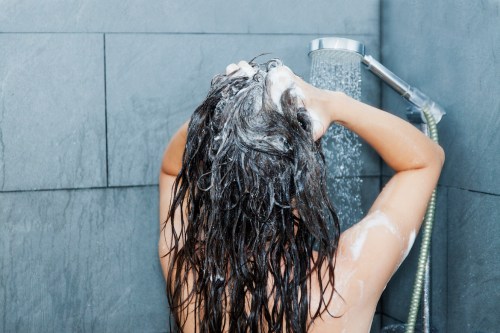Our editors independently select these products. Making a purchase through our links may earn Well+Good a commission
How To Clean Your Filthy Showerhead in 5 Easy Steps
If you're hoping to prevent clogs and build up of debris (as well as avoid skin problems), you need to routinely clean your showerhead.

Cleaning your showerhead might not be on your to-do list, but there’s good reason to make it a priority the next time you clean the bathroom. Mineral deposits that form over time reduce water pressure while serving as a breeding ground for bacteria. For the sake of your skin, you should clean your showerhead at least once per month.
Experts in This Article
Kathy Cohoon is a cleaning expert with Two Maids & A Mop.
How Does a Showerhead Get Dirty and Clogged?
Your shower drain gets clogged and needs to be regularly cleaned for maintenance. Similarly, the showerhead develops limescale that inhibits proper functioning and can cause skin issues.
“A clogged showerhead is likely due to a buildup of mineral deposits from the water that flows through it,” says Kathy Cohoon, cleaning expert with Two Maids & A Mop. And dirt is even more likely to accumulate inside a showerhead if you take long, hot showers every day.
The longer and hotter the shower, the more damage you’re causing and the more rapid the build up. The metal material that’s in a showerhead is more likely to rust when exposed to heat—especially when exposed for a long duration and with every use.
Another reason why dirt may get trapped in a showerhead is due to poor cleaning habits, where you’re not properly cleaning your showerhead or you’re waiting too long to clean it. When you don’t clean your showerhead often enough, there’s more opportunity for the showerhead to clog due to build up of calcium deposits, grime and other kinds of debris.
Plus, a dirty showerhead can even wreak havoc on your skin and hair health, too, due to bacteria, hard water and mold, all of which may be lurking in your showerhead and can lead to skin infections and rashes, unless properly monitored and managed.
Although a clogged showerhead can be frustrating, the individual mineral particles are small and so are pretty easy to break down, as long as you’re using the right solution, for most effective results. If you’re hoping to prevent clogs and build up of debris (as well as avoid skin problems), you need to routinely clean your showerhead. But that’s easier than you might think. Follow along with the steps below.
How To Clean a Showerhead: A Step-by-Step Guide
What you’ll need:
- screwdriver
- distilled vinegar
- plastic bag
- rubber band (or zip tie)
- plastic scrub brush
- mold and mildew remover (optional)
1. First, unscrew your showerhead with a screwdriver or wrench and remove it from the holder.
2. Pour vinegar into a plastic bag that’s large enough to fit around the showerhead.
3. Using a rubber band or zip tie, secure the bag around the showerhead, with the head fully submerged. Leave the showerhead submerged for at least an hour or overnight, the latter for when you really need a deep cleaning. The vinegar should loosen the mineral deposits naturally over time.
4. After you’ve allowed the head to soak and the vinegar solution to loosen deposits and other debris, remove the bag of vinegar and scrub away at the loosened material with a plastic scrub brush (or a spare toothbrush). Continue cleaning and scrubbing, until you’ve cleared away all signs of buildup and any gunk that’s causing the clog and is stuck in the showerhead.
5. Let some water run to clean the showerhead and to remove any residue of vinegar. The use of vinegar as a cleaning solution should be sufficient for getting rid of the build up inside the showerhead, as well as for eliminating any presence of limescale and mold. However, if there’s too much mold overgrowth and you find that it’s lingering and too potent to remove with the vinegar soak and a brush, you may need to apply a mold or mildew remover, such as Tilex Mold & Mildew ($15), as a final step to really get the job done right.
Sign Up for Our Daily Newsletter
Get all the latest in wellness, trends, food, fitness, beauty, and more delivered right to your inbox.
Got it, you've been added to our email list.








